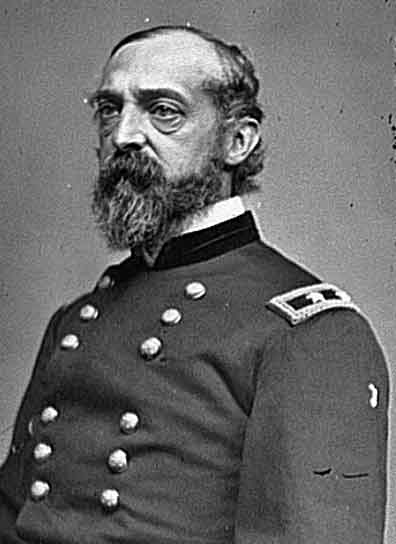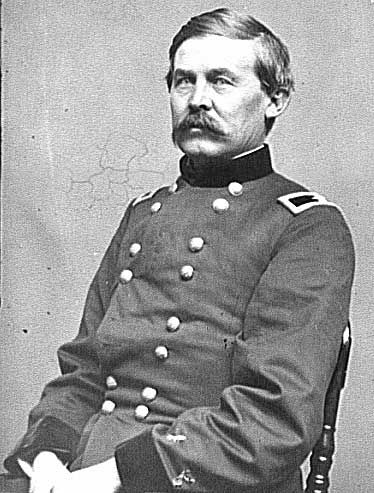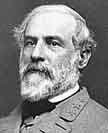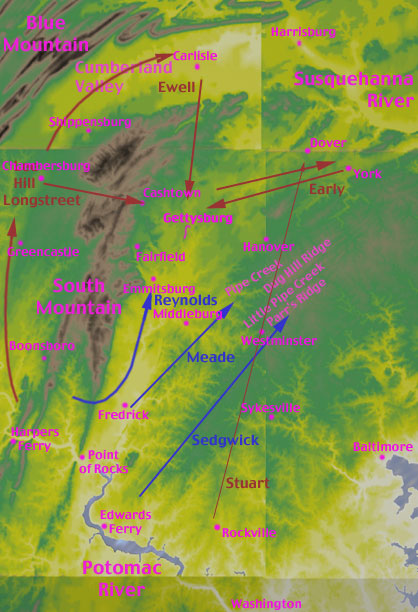Approaches to
Gettysburg
North
|
"General Sickles, this is in some respects higher ground
than that to the rear, but there is still higher in front of
you, and if you keep on advancing you will find constantly
higher ground all the way to the mountains."
|
|

|
Maj. General George Meade, Army of the
Potomac
(cwp 4a40288)
|
General Meade was given command of the Army of the Potomac (AoP)
three days before Gettysburg. While most AoP commanders had several
months to ready a staff and tune the army, Meade had no choice but to
start immediately in pursuit of Lee.
Meade had orders to cover Washington. This was a perpetual problem
for the AoP. The War Department was conservative. In spite of a ring
of forts, they constantly directed the AoP to move right and left to
keep itself between Washington and Lee. (A year later, Grant would
order Sheridan to put himself south of the enemy, and follow them to
the death. Lincoln, noting the exchange, told Grant that this was
exactly right, but warned that the War Department would block such an
action if Grant did not press it.)
Meade also had political difficulties. While Lincoln sought
perpetually a general who would fight, the Congress sought commanders
who were Republican and devout abolitionists. Meade was Lincoln's
latest attempt to find a fighter. Sickles was a politician, a friend
and political ally of General Hooker, the AoP commander Meade
replaced. Sickles taking his III Corps forward at Gettysburg might
have been done as much in spite as for glory or for military reasons.
Certainly, Sickles continued political and public relations attacks
on Meade well after the war ended.
Finally, not only Meade but the whole Army of the Potomac had a
problem in confidence. By one report, it was not a lack of faith in
the northern generals, but an extreme high respect for Robert E. Lee.
The AoP had been defeated too often. The Gettysburg campaign was
fought by the north on the defensive, tactically and emotionally.
While they finally managed to protect themselves from the south's
traditional flanking maneuvers, they did so passively. An aggressive
general might have viewed Lee's habit of dividing his army as
opportunity. No one in the Gettysburg command staff contemplated
taking advantage of southern dispersion by going on the
offensive.
Meade divided his army into three wings of several Corps each,
started them north, fanning them out into an east-west line shielding
Washington from Lee. The three wings had to be spread to cover
Washington, but had to be close enough to support one another. Each
wing was put under the command of a general trusted by Meade. As the
army started north after Lee, Meade developed plans for a defensive
line at Pipe Creek. Like Longstreet, Meade wanted to fight on the
defensive from high ground. Meade's Pipe Creek Circular established
plans for the three army wings to cover Washington from a northeast
to southwest running ridge.
Approaches to Gettysburg
The Pipe Creek plan never went into effect. At Gettysburg, twenty
miles in front of Meade's proposed Pipe Creek line, Union Cavalry
General Buford had also recognized good ground for a defensive stand.
Not having received the Pipe Creek plan, suspecting but not certain
that Lee was concentrating his entire force on Gettysburg, Buford
resolved to protect the "lovely ground" at Gettysburg, and called on
General Reynold's left wing of the AoP to support him.
|
"They will attack you in the morning; and they will come
'booming' -- skirmishers three deep. You will have to fight
like the devil to hold your own until supports arrive."
|

|
Brigadier General John Buford, 1st Division, US
Cavalry
(cwp 4a40403)
|
Meade's march north was logical and perhaps unremarkable, except
the rate of travel. The Gettysburg campaign was unusual for the
amount of ground covered by the Army of the Potomac. With the
exception of the Petersburg to Appomatox Court House final campaign,
the AoP never moved so far so fast. The Gettysburg marches were long
remembered as exhausting, with 20 to 30 miles covered per day a
common achievement.
Mead's marching doctrine might well have been influenced by
General Grant's Vicksburg campaign. Grant had loaded his men with
food and ammunition, crossed the Mississippi River, then proceeded on
several days of hard marching and hard fighting while not maintaining
a supply train. As his columns were not slowed by wagons, and he
needed not expend troops to guard the trains, Grant was able to
rapidly fight two quick battles and establish a siege before
returning to the Mississippi to resupply. The Gettysburg campaign was
the first eastern effort following Grant's innovative Vicksburg
marches. Meade extensively parked his wagon trains, giving first
priority on roads to the fighting troops.

|
"I could not believe they were all there"
R. E. Lee
|
In 1862, the Army of the Potomac averaged 6 miles a day on the
march. Increasing this suddenly to 20 miles plus severely upset
southern expectations and planning. Had Meade not parked the wagons,
Stuart's eastward route to join Early in York would have worked in a
timely fashion. Lee would have had a screening and scouting force
informing him of Union troop locations. Finally, while some small
part of the Army of the Potomac might have reached Gettysburg on the
first three days of July, they could not all be there. Any assault
launched on July 2nd and 3rd would have been launched against a
portion of the Army of the Potomac, not the full force. Lee ordered
Longstreet's failed July 2nd and 3rd assaults under the assumption
that the South still enjoyed the same sort of numbers advantage as
they had on July 1st.
This change in marching doctrine is much neglected in the
histories, but is key to two southern controversies. Why was Lee
pushing the offensive on July 2nd and 3rd? Lee believed he had a
numbers advantage. He "could not believe they were all there" waiting
for him on Cemetery Ridge. Why was Stuart late in joining Lee? Stuart
wasn't late. The Union was early, moving troops between Stuart and
Lee faster than expected, forcing Stuart to fight, and not giving him
time to perform his scouting mission before the battle opened. Lee
and Stuart made their decisions based on years of experience dealing
with the Army of the Potomac. Their critics fault them based on 20 20
hindsight, complete knowledge of where the Union troops actually
were, the equivalent of perfect scouting, neglecting entirely the fog
of war. It might be more reasonable to credit Meade for upgrading the
performance of the Union Army rather than fault Lee and Stuart for
basing plans on past experience.
Ironically, Lee too had dropped his line of supply, also imitating
a western strategy. However, Lee was raiding, not parking his wagons
for speed. No way could Lee protect a supply line from Pennsylvania
back to Virginia. Still, there were several times where Lee could
have speeded his troops along by parking his wagons. The traffic jam
coming through the South Mountain passes could have been relieved by
a troops first wagons last policy. Both commanders were borrowing
innovative logistic ideas from the western campaigns, but with
different emphasis.
Southern historians still debate what Lee's strategy was, or ought
to have been. If well over a century later, we still are not sure of
Lee's thinking, consider that Meade had to account for all
possibilities of what Lee might have been trying to do. If Lee was
attempting to aggressively strike dispersed and exhausted Union
columns, Meade had to keep his men within supporting distance of one
another, and rapidly concentrate once the battle started. If Lee was
threatening Washington, Meade had to keep between Lee and Washington.
If Lee was seeking defensive battle, Meade would have to be careful
to only commit to battle on favorable terms. If Lee was seeking to
avoid battle, Meade would have to put enough men close enough to
Lee's army that he would have to stop raiding, would have to
concentrate for battle, and thus would have to either give battle or
starve.
By ordering Meade to protect Washington, the War Department forced
Meade on the strategic defensive. Meade could not impose his will on
Lee. He could only try to prevent Lee from imposing his own will. The
problem, and not an easy problem in this case, is that the defending
army does not know what the aggressor army intends, and thus has to
counter anything they might try. Meade did this. While it is still
quite possible to ask what Lee was trying to achieve, or second guess
what Lee ought to have tried to achieve, one cannot be too critical
of Meade's response. Lee's intent, whatever it was, was anticipated
and blocked.
Next: Position
Maps showing the three days marching towards
Gettysburg.


